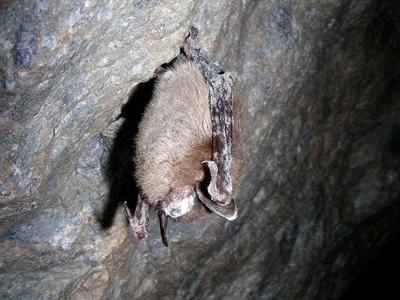Deadly bat disease kills entire colonies
White Nose Syndrome comes from an invasive fungus that eats away at the bat’s muzzle and wings. (Photo courtesy of the U.S. Fish and Wildlife Service).
Story by Living on Earth. Listen to audio above for full interview.
Scientists have finally determined what is killing off thousands of bats across the Northeast and parts of sourthern Canada.
The disease is White Nose Syndrome, which first appeared in the U.S. around 2006, but the true culprit causing the mass die-offs is a European cold-loving fungus called Geomyces destructans.
Carol Meteyer is a pathologist with the U.S. Geological Survey at the National Wildlife Health Center, and a member of the team that discovered the source of the disease. Meteyer said that even though the disease’s name refers to the infected muzzle of a bat, the fungus has a more severe effect on a bat’s wings.
“[The fungus] colonizes the skin’s surface, it begins to erode through that epidermis and it actually gets down into the connective tissue,” Meteyer said. “And the wing membrane of bats is incredibly delicate. There’s one cell layer on top, there’s one cell layer on the bottom, and then there’s just a fine connective tissue, lace network that has nerves and blood vessels, but you could almost see through it.”
A bat’s wings are critical during hibernation. Wings regulate body temperature, maintain hydration, and even help with respiration. But winter hibernation is also when Geomyces destructans strikes. Meteyer said when animals hibernate, they also downgrade their immune systems to conserve energy for the long winter — making the bats more vulnerable to invasive pathogens.
“Usually these pathogens have evolved with the bats and probably also hibernate. But Geomyces destructans, White Nose Syndrome, grows at the ideal temperature of the bat’s skin when it’s hibernating and it erodes through their skin without even being recognized until they come out of hibernation in the spring,” Meteyer said. The bats that survive until spring are completely rejuvenated when they wake up and begin feeding. But in some colonies, White Nose Syndrome wipes out 90 percent of the population — nationwide that is hundreds of thousands of bats.
For years the disease confounded American scienctists, until recently when biologists in Europe pointed out that European bats showed the same symptoms, but weren’t dying from it. Meteyer believes that success of the European bats is not because they have stronger immune systems, but because European winters are shorter and milder than American winters.
“[The European bats] may not be in those caves with immune suppression long enough to have this fungus really have the devastating effect that it has on our northeastern bats,” Meteyer said.
Treatment is still an ongoing process. Spraying fungicides could end up killing more bats — and the other cave flora and fauna — rather than eradicating the deadly fungus.
“It’s something that is being worked on and being investigated, but it’s not going to be a quick fix,” Meteyer said.
————————————————————
Hosted by Steve Curwood, “Living on Earth” is an award-winning environmental news program that delves into the leading issues affecting the world we inhabit. More about “Living on Earth.”
